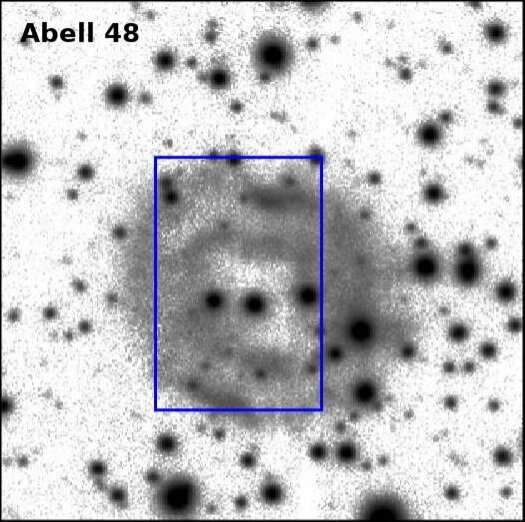January 3, 2022 report
Spatio-kinematic properties of planetary nebula Abell 48 explored by recent research

Astronomers have conducted a comprehensive spatio-kinematic study of a planetary nebula known as Abell 48. Results of the research could improve our knowledge about the properties and nature of this object. The study was published December 22 on the arXiv pre-print repository.
Planetary nebulae (PNe) are expanding shells of gas and dust that have been ejected from a star during the process of its evolution from a main sequence star into a red giant or white dwarf. They are relatively rare, but are important for astronomers studying the chemical evolution of stars and galaxies.
Discovered in 1955, Abell 48 (also known as PN G029.0+00.4) is a PN around a rare Wolf-Rayet (WR) star. It showcases a ring-shaped morphology with a mean angular diameter of 40'', without any visible halo. The metallicity of this PN still remains uncertain as well as many of its other parameters.
A team of astronomers led by Ash Danehkar of the University of Michigan decided to shed more light on the properties of Abell 48 by analyzing the available observational data, mainly from the Wide Field Spectrograph (WiFeS), on the 2.3-m telescope operated by the Australian National University (ANU). The dataset allowed them to develop a 3D kinematic model of this PN.
"Using the integral field observations of the Hα λ6563 and [N II] λ6584 line emissions, we conducted a comprehensive spatio-kinematic analysis of this PN. A three-dimensional spatio-kinematic ionization model was developed with the kinematic modeling tool SHAPE to replicate the observed spatially-resolved velocity channels and position–velocity diagram," the researchers wrote in the paper.
By conducting kinematic analysis of the hydrogen-alpha emission, it was found that Abell 48 has a deformed elliptic toroidal shell with an outer radius of approximately 23 arcseconds and a thickness of about 15 arcseconds. This shell is associated with an integrated hydrogen-alpha emission-line expansion of about 35 km/s.
Moreover, the study identified the presence of a narrow (approximately 3 arcseconds) exterior low-ionization structures surrounding the shell of Abell 48. The astronomers assume that these structures could have formed as a result of shock collisions with the interstellar medium (ISM).
When it comes to the central star of Abell 48, it was found that it is a rare Wolf-Rayet star of spectral type WN5. The star is hydrogen-deficient and the authors of the paper suppose that its hydrogen-rich stellar layer was lost to a companion object.
"We know that some PNe with similar elliptical ring-shaped morphology evolved from common envelopes with binarity, such as Abell 63 (Mitchell et al. 2007), Abell 41 (Jones et al. 2010), Sp 1 (Jones et al. 2012), and HaTr 4 (Tyndall et al. 2012), whose symmetric axes are roughly perpendicular to their binary orbital planes," the researchers explained.
They propose further in-depth monitoring the central star of Abell 48 in order to verify the binary system hypothesis. Such observations could also explain the formation of this star and nebular morphology of the PN around it.
More information: A. Danehkar, 3D spatio-kinematic modeling of Abell 48, a planetary nebula around a Wolf-Rayet [WN] star. arXiv:2112.12043v1 [astro-ph.SR], arxiv.org/abs/2112.12043
© 2022 Science X Network





















